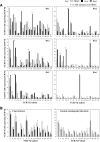Oligoclonal expansions of CD4+ and CD8+ T-cells in the target organ of patients with biliary atresia
- PMID: 17631149
- PMCID: PMC1949019
- DOI: 10.1053/j.gastro.2007.04.032
Oligoclonal expansions of CD4+ and CD8+ T-cells in the target organ of patients with biliary atresia
Abstract
Background & aims: Biliary atresia is an inflammatory, fibrosclerosing neonatal cholangiopathy, characterized by a periductal infiltrate composed of CD4(+) and CD8(+) T cells. The pathogenesis of this disease has been proposed to involve a virus-induced, subsequent autoreactive T cell-mediated bile duct injury. Antigen-specific T-cell immunity involves clonal expansion of T cells expressing similar T-cell receptor (TCR) variable regions of the beta-chain (Vbeta). We hypothesized that the T cells in biliary atresia tissue expressed related TCRs, suggesting that the expansion was in direct response to antigenic stimulation.
Methods: The TCR Vbeta repertoire of T cells from the liver, extrahepatic bile duct remnants, and peripheral blood of biliary atresia and other cholestatic disease controls were characterized by fluorescent-activated cell sorter analysis, and TCR junctional region nucleotide sequencing was performed on expanded TCR Vbeta regions to confirm oligoclonality.
Results: FACS analysis revealed Vbeta subset expansions of CD4(+) and CD8(+) T cells from the liver or bile duct remnant in all patients with biliary atresia and only 1 control. The CD4(+) TCR expansions were limited to Vbeta3, -5, -9, and -12 T-cell subsets and the CD8(+) TCR Vbeta expansions were predominantly Vbeta20. Each Vbeta subset expansion was composed of oligoclonal populations of T cells.
Conclusions: Biliary atresia is associated with oligoclonal expansions of CD4(+) and CD8(+) T cells within liver and extrahepatic bile duct remnant tissues, indicating the presence of activated T cells reacting to specific antigenic stimulation. Future studies entail identifying the specific antigen(s) responsible for T-cell activation and bile duct injury.
Figures







References
-
- Sokol RJ, Mack CL. Etiopathogenesis of biliary atresia. Semin Liver Dis. 2001;21:517–524. - PubMed
-
- Schreiber RA, Kleinman RE. Genetics, immunology and biliary atresia: an opening or a diversion? J Pediatr Gastroenterol Nutr. 1993;16:111–113. - PubMed
-
- Morecki R, Glaser JH, Cho S, Balistreri WF, Horwitz MS. Biliary atresia and reovirus type 3 infection. N Engl J Med. 1982;307:481–484. - PubMed
-
- Tyler KL, Sokol RJ, Oberhaus SM, Le M, Karrer FM, Narkewicz MR, Tyson RW, Murphy JR, Low R, Brown WR. Detection of reovirus RNA in hepatobiliary tissues from patients with extrahepatic biliary atresia and choledochal cysts. Hepatology. 1998;27:1475–1482. - PubMed
-
- Riepenhoff-Talty M, Gouvea V, Evans MJ, Svensson L, Hoffenberg E, Sokol RJ, Uhnoo I, Greenberg SJ, Schakel K, Zhaori G, Fitzgerald J, Chong S, el-Yousef M, Nemeth A, Brown M, Piccoli D, Hyams J, Ruffin D, Rossi T. Detection of group C rotavirus in infants with extrahepatic biliary atresia. J Infect Dis. 1996;174:8–15. - PubMed
Publication types
MeSH terms
Substances
Grants and funding
LinkOut - more resources
Full Text Sources
Research Materials

